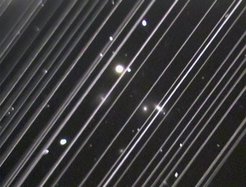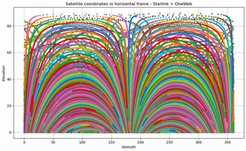Protection of the Dark and Quiet Sky from Satellite Constellation Interference
Press conference for the inauguration of the new IAU Centre, run by NOIRLab and SKAO
The International Astronomical Union (IAU) established a new center for the protection of the night sky from interference by satellite constellations on February 2, 2022. The proposal, led by the U.S. consortium NoirLAB (optical astronomy) and the international SKA Observatory (radio astronomy), supported by the Max Planck Institute for Radio Astronomy (MPIfR), received strong support from the IAU. Several representatives of the Institute, including Professor Karl Menten, Director at the MPIfR, attended the inauguration of the center.
A press conference on the event was live-streamed on February 3, 2022 and is available as a recording on the IAU's Youtube pages.

Satellites will be used more and more for commercial applications. For example, Internet access is already possible to some extent through satellite communication and will be expanded by the creation of so-called mega-constellations, tens of thousands of satellites in low-Earth orbits at altitudes between about 500 and 1000 kilometers. This is intended to ensure high-speed Internet access everywhere on Earth. While on the one hand it represents a breathtaking technical achievement for the general benefit, there are also downsides. By reflecting sunlight and generating radio radiation (for communication, but also unintentionally), the satellites appear as moving light or radio sources in the sky and can thus be a significant source of interference for astronomical observations. This is true for a number of applications not only in professional astronomy. Depending on the technical design, such satellites can even be seen with the naked eye in low Earth orbits.
Press Conference, February 03, 2022 (Youtube Recording)
To protect the night sky from excessive contamination by megaconstellations and to contribute to the successful coexistence of innovation and research, the IAU has launched the IAU Centre for the Protection of the Dark and Quiet Sky from Satellite Constellation Interference. An international team, including all observatories around the globe, will search for technical and software solutions to deal with the interference in the best possible way. In addition, solutions will be sought to ultimately advise satellite operators on how to make satellites as invisible as possible (for optical and for radio waves!) to all observers of the night sky. Another task is to make politicians and the general public aware of the rapidly approaching problem of contamination of the night sky and the need for protective measures.
The MPIfR is already active in various national, European and international committees to protect radio astronomical measurements from interference. MPIfR’s Dr. Benjamin Winkel is the chair of the Committee on Radio Astronomy Frequencies (CRAF) of the European Science Foundation. Professor Michael Kramer, Director at the MPIfR, leads a European working group within the framework of the European Opticon-Radionet pilot project for the joint protection of optical and radio astronomy from artificial interference. The MPIfR is involved in both organisations with additional employees and will contribute to the IAU centre through its work in both groups as well as directly.


